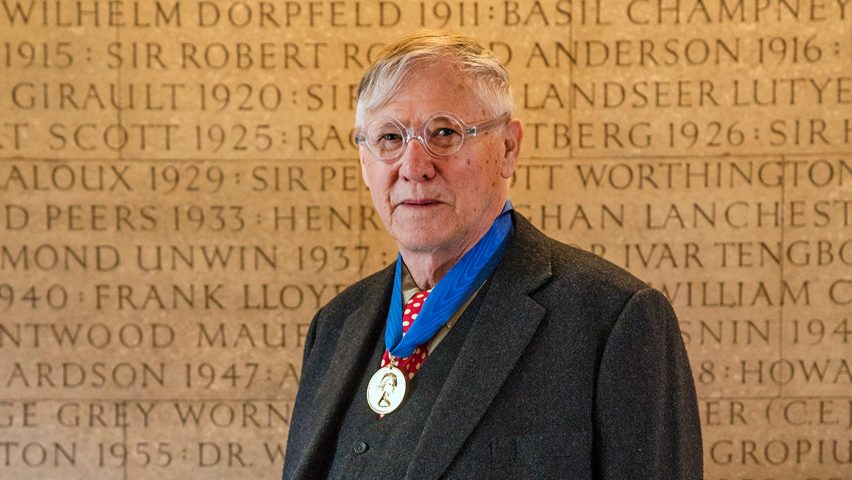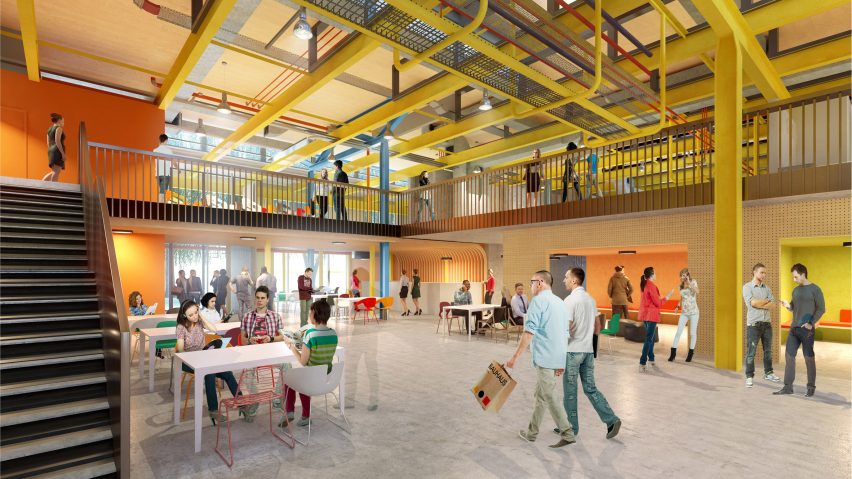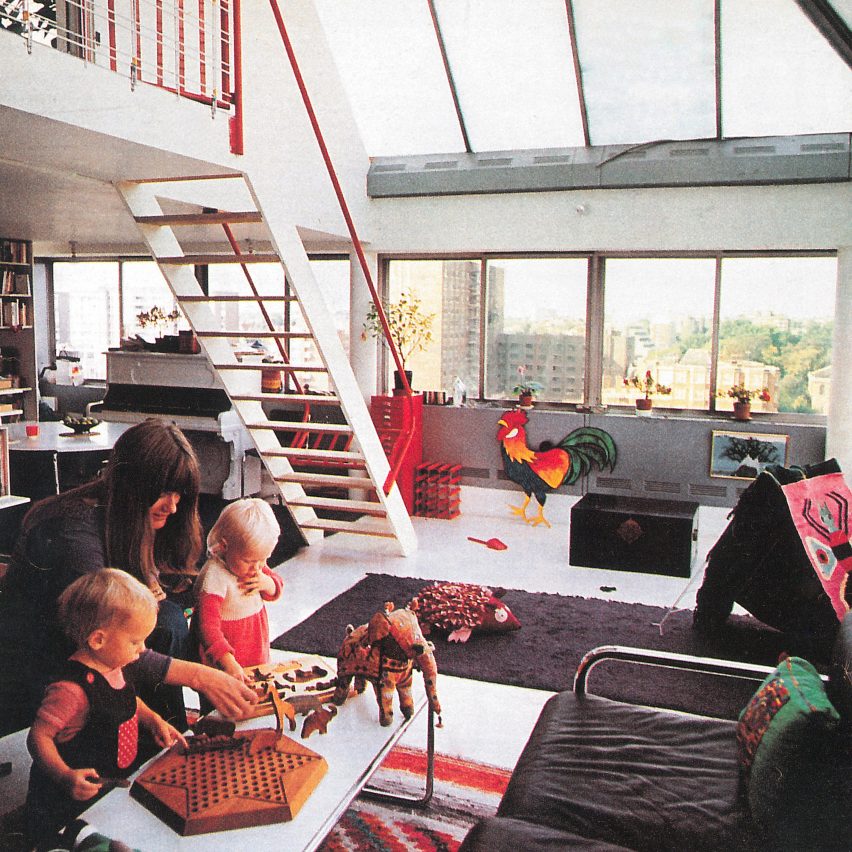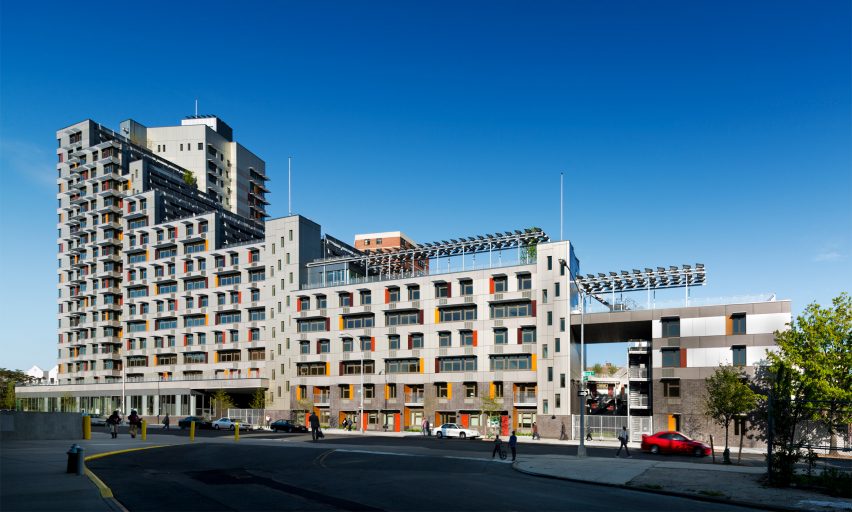
"The most destructive thing is to demolish a building" says Nicholas Grimshaw
We should be wary of "handbag architecture", design buildings that are reusable and embrace micro homes, says RIBA Royal Gold Medal 2019 winner Nicholas Grimshaw.
Grimshaw, founder of Grimshaw Architects, told Dezeen he is "very passionate" about reusing buildings, instead of the trend for handbag architecture – or celebrity buildings – that "are only any use for what they're first designed for".
"The most destructive thing is to demolish a building, get rid of all the demolished material, and then build another one," he said.
He also welcomed the construction of micro homes, which he said can give "people a real kickstart", in a wide-ranging interview ahead of receiving the Royal Gold Medal on Thursday 14 February.
"Celebrity buildings don't have any relevance"
Grimshaw, the architect of the Eden Project and Waterloo station's International Terminal, is often held up as being at the vanguard of the high-tech movement, an architectural style born in the 1970s that has cutting-edge technology at its core.
The architect now has mixed feelings about the term high-tech and its wide usage.
"It's such a wide expression. I mean, they use if for coffee pots and toasters," Grimshaw told Dezeen. "It got applied to practically everything, even pairs of shoes in the end, which for architecture is not nearly as precise enough."
However, Grimshaw is happy when the style is used to describe alternatives to "handbag architecture" – a phase he coined to refer to buildings that a client selects from a limited range of options, in a similar manner to purchasing a luxury handbag.
"I don't mind if it's an alternative to what I call handbag architecture," he said. "I think architecture deserves much more concentration than that."

Handbag architecture, he argues, goes hand in hand with the desire for "celebrity objects" – famous buildings designed by star architects, that often do not have reuse or adaptability in mind.
"Very often these handbag architecture buildings are only any use for what they're first designed for. Nobody knows what the hell to do with them afterwards," he said.
"With design ingenuity you can make existing buildings work anew"
Adapting buildings, rather than knocking them down to start afresh, is a key part of Grimshaw's work.
His practice is currently converting the Herman Miller furniture factory it built in Bath in 1976 into an art and design faculty for Bath Spa University. The original building was designed to be adaptable, with demountable cladding that allows for windows doors to be re-arranged and recessed courtyards that can be shifted.
"When with a bit of real design ingenuity you can make an existing building work anew for something else," he said.

"I've got very passionate about it lately. I've even suggested that when architects submit a building for planning permission they should be asked to suggest ways in which it can be used for alternative things in the future," he continued.
"The more of that that goes on in the world, the better place the world will be."
Micro homes aren't "slums for the future"
Grimshaw also called for housing architects to embrace co-ownership, customisation and micro homes.
His first residential project – 125 Park Road, completed in 1970 – applied office-design thinking to a residential block, with the services concentrated in the centre to free up space for living. This created the potential for customisation.
"They were genuine studios that people had to fit out themselves," Grimshaw explained.
"I think there's a real place for that now. Even when people build new, they should build much more of a framework which can be filled in or developed by individual people to suit their own needs."

Grimshaw incorporated this thinking at Via Verde – a residential development in New York that has a mix of private and co-ownership apartments, which are offered as basic units that residents can customise.
And while some architects are against micro homes, he believes these residence can create opportunities.
"I'm taken aback by people who express shock and horror when people build very small units, saying you're building slums for the future," he said. "It doesn't matter how small it is, it's a starter unit. If they're well designed you could give people real kickstart."
Main portrait is by Morley von Sternberg.
Read the full transcript of Dezeen's interview with Nicholas Grimshaw here:
India Block: Congratulations! How does it feel being the recipient of this year's Royal Gold Medal?
Nicholas Grimshaw: To win the Gold Medal is a terrific thrill, there's no question about it. Your name gets chiselled in stone and that's an extraordinary thing. If you look where those names are chiselled, my God, they've got everybody. Gropius, Le Corbusier, Mies, everybody is there.
India Block: RIBA said that it was long overdue. Did you feel it was a long time coming?
Nicholas Grimshaw: These things are very ad-hoc, in a way. They have somebody in mind and then something happens or somebody dies. Perspective changes, there's a certain amount of fashion in it, you know whether brutalism is in or not. I think it's just a wonderful sort of windfall if you get it.
India Block: Do you think that's there's something that's come back into fashion with your work, something that's more relevant or pertinent again now?
Nicholas Grimshaw: No, I like to think we've been consistent and kept going with our approach to work. We believe in details of the building being explicit. We have an idea that buildings should have good bones and they should be reusable, particularly in this day and age.
I think the most destructive thing is to demolish a building, get rid of all the demolished material, and then build another one. When with a bit of real design ingenuity you cab make an existing building work anew for something else
I've got very passionate about it lately. I've even suggested that when architects submit a building for planning permission they should be asked to suggest ways in which it can be used for alternative things in the future.
It's a bit fanciful really, but it's to really to enhance awareness of the fact that's happening, that many office buildings are turning into apartment buildings.
I don't think there's anything criminal about having a very, very small apartment
We've got a factory building in Bath that we did for Herman Miller, the furniture people, which is now becoming the Faculty of Arts and Design for Bath Spa University. Which is a wonderful example of using an industrial building for the university faculty.
The more of that that goes on in the world, the better place the world will be.
India Block: What about these cases of less-scrupulous developers taking advantage of the rules, negating minimum space requirements if you convert an office building into housing?
Nicholas Grimshaw: I don't think there's anything criminal about having a very, very small apartment, like a ship's cabin with everything built in. I think it's the way it's done, and it's a real open field for designers actually to come up with ingenious solutions.
India Block: One of your earlier works with Tim Ferris was applying office typology to a residential block with 125 Park Road. Do you still refer to that project?
Nicholas Grimshaw: I do. I was very touched recently that the building got listed. I never thought in a million years when I was designing it, it would end up as a listed building.
When people build new, they should build much more of a framework that can be filled in by individual people
One of the things they say is that they see it as one of the first real loft buildings. Which to me was simply a turn of phrase. What we did was actually strip everything we possibly could out of it, skirtings, door architraves, door handles, light fittings, so that we can make the space as big as we could. They were genuine studios that people had to fit out themselves.
I think there's a real place for that now. Even when people build new, they should build much more of a framework that can be filled in or developed by individual people to suit their own needs. The building what used before luxury apartments, which still goes on in New York in a big way, should be looked at in a different kind of way.
We've done quite a big housing scheme in New York called Via Verde, and that's a mixture of co-ownership housing, private housing, a mix of different types of ownership.
They're pretty basic units using quite interesting new materials which are recycled bits and pieces. It's a pretty green building in terms of ventilation and everything else. And I think there's not enough thought of that kind of thing. Particularly in New York, where you tend to get rock bottom public housing if any at all, or luxury apartments, and there's not a lot in between.
India Block: You've always been excited buying new materials and technology. What are you really interested in the moment that's been newly developed or freshly applied to architecture?
Nicholas Grimshaw: Recycling comes into it in a big way. One of the nicest bits of recycling I came across was a student proposal for the entrance to Hyde Park. You had these great big, car-sized machines, you tossed your water bottle or plastic bottles into them, and it produced park benches. It was a wonderful example of recycling the bottles that are chucked all around the park into usable objects. That kind of recycling I think is wonderfully exciting really.
Maybe we can send a proper giant vacuum cleaner down to the ocean floor, suck up the plastic and turn it into eating utensils
Now they're discovering the oceans are coated with endless little pellets of plastic. Maybe we can send a proper giant vacuum cleaner down to the ocean floor, suck up the plastic and turn it into eating utensils. Any kind of recycling is really worth looking at.
India Block: I've read that you don't really like the term "high-tech movement" to describe your work. Would you be able to unpack why that is for me?
Nicholas Grimshaw: It's such a wide expression. I mean, they use if for coffee pots and toasters and you know, bridges and railways and railway stations and God knows what. What it actually means is, I hope, is a strong engineering base, what I call good bones to a building.
But it's a facile kind of usage of it. It got applied to practically everything, even pairs of shoes in the end, which for architecture is not nearly as precise enough. I don't mind if it's an alternative to what I call handbag architecture.
India Block: What's handbag architecture?
Nicholas Grimshaw: Handbag architecture is when, say, a client has a choice of models of building like six in a row on a shelf and they just choose one. There's no depth to the discussion, they're doing it entirely on visual means, like choosing a coffee pot or something.
I think architecture deserves much more concentration than that. Solutions should be looked at really, really hard and functionally, and whether they really work or not.
India Block: You studied under Peter Cook. Do you share his general disappointment with the standard of architecture in the UK at the moment? Or even globally? Do you think that it's become quite built to order?
Nicholas Grimshaw: This handbag architecture speaks to the celebrity side of life, for celebrity objects. They design celebrity buildings and I don't think that has any relevance to anything really.
Handbag architecture buildings are only any use for what they're first designed for. Nobody knows what the hell to do with them afterwards
Especially if you consider the reuse and recycling of them. Very often these handbag architecture buildings are only any use for what they're first designed for. Nobody knows what the hell to do with them afterwards.
I don't want to go on about it, people are entitled to have whatever they like if they've got a lot of money to spend, but I think that trend is perhaps is what Peter Cook's describing.
It's a bit disappointing that those kind of buildings get such publicity when perhaps buildings done by young practitioners just got ignored because they're not celebrities.
India Block: Over your 50-year career, what are the most exciting advancements you've seen in architecture and technology?
Nicholas Grimshaw: Actually right now is quite a good time to be in, looking for new materials. For instance, the government intends to pass a law that you can't use flammable materials on the outside of housing. That opens the doors to all kinds of materials made of rubble and waste products.
Re-using buildings in itself generates a requirement for new materials.
India Block: Do you think people under more pressure to innovate, given our expanded idea of what's happening with the climate on the planet at the moment?
Nicholas Grimshaw: Up to now there's been the most extraordinary fatalism about it. That it's too late, there's nothing more we can do, the filth's up to there, it all happened in the Victorian times it's not our fault.
The government's been pretty weedy in terms of legislation on any of this
Attitudes like that are going to change. The government's been pretty weedy in terms of legislation on any of this. I think regulations about industry polluting the atmosphere and materials which cost a lot of energy to produce being used – there are endless, really simple, broad curbs that the government could bring in. It's non political really, these things should be done absolutely, regardless.
It's quite an exciting time to live in in terms of new materials, after a period of stagnation.
India Block: Do you have any thoughts on the new government housing commission, Building Better, Building Beautiful?
Nicholas Grimshaw: It seems to be reinventing the situation where we were in the 70s when we built Park Road, which was cooperative housing. You could argue that's 50 years ago and not much has actually happened, except the number of council housing was reduced by several million because of the Right to Buy.
That's really what's been the big shift in the whole housing issue. When people feel a sense of ownership, they probably do spend money fitting out their own dwelling and make it theirs, so to speak, but that hasn't increased the quantity or quality of housing at all.
India Block: Where do you see the future of housing?
Nicholas Grimshaw: I personally would love to see more sort of framework-type buildings where people make a much bigger contribution to the construction and what's happening themselves, and they're not just looking for ready made, off the shelf solutions.
It's pretty risky if you rely on other people to define how you want to live
People need to get in the mood to join in, collaborate and develop ideas for housing themselves and how they want to live. It's pretty risky if you rely on other people to define how you want to live. People should speak out more about how they want to live, and I think cooperative housing is a very good way of doing it.
India Block: What do you think younger people who are locked out of the housing market in big cities should they be doing?
Nicholas Grimshaw: Young people should be lobbying for starter units.
I'm taken aback by people who express shock and horror when people build very small units, saying you're building slums for the future. It doesn't matter how small it is, it's a starter unit. If they're well designed you could give people real kickstart.
The thing the young people are against is lack of money, that's the brick wall they’re up against. So you've got to produce things which are cheap but good, cheap but economical, which offer a community and a way forward. It's perennial problem, it certainly goes back through my 50 years as an architect.
Getting together enough money to actually start has always been a problem. Maybe the only way of solving that is to give people money.